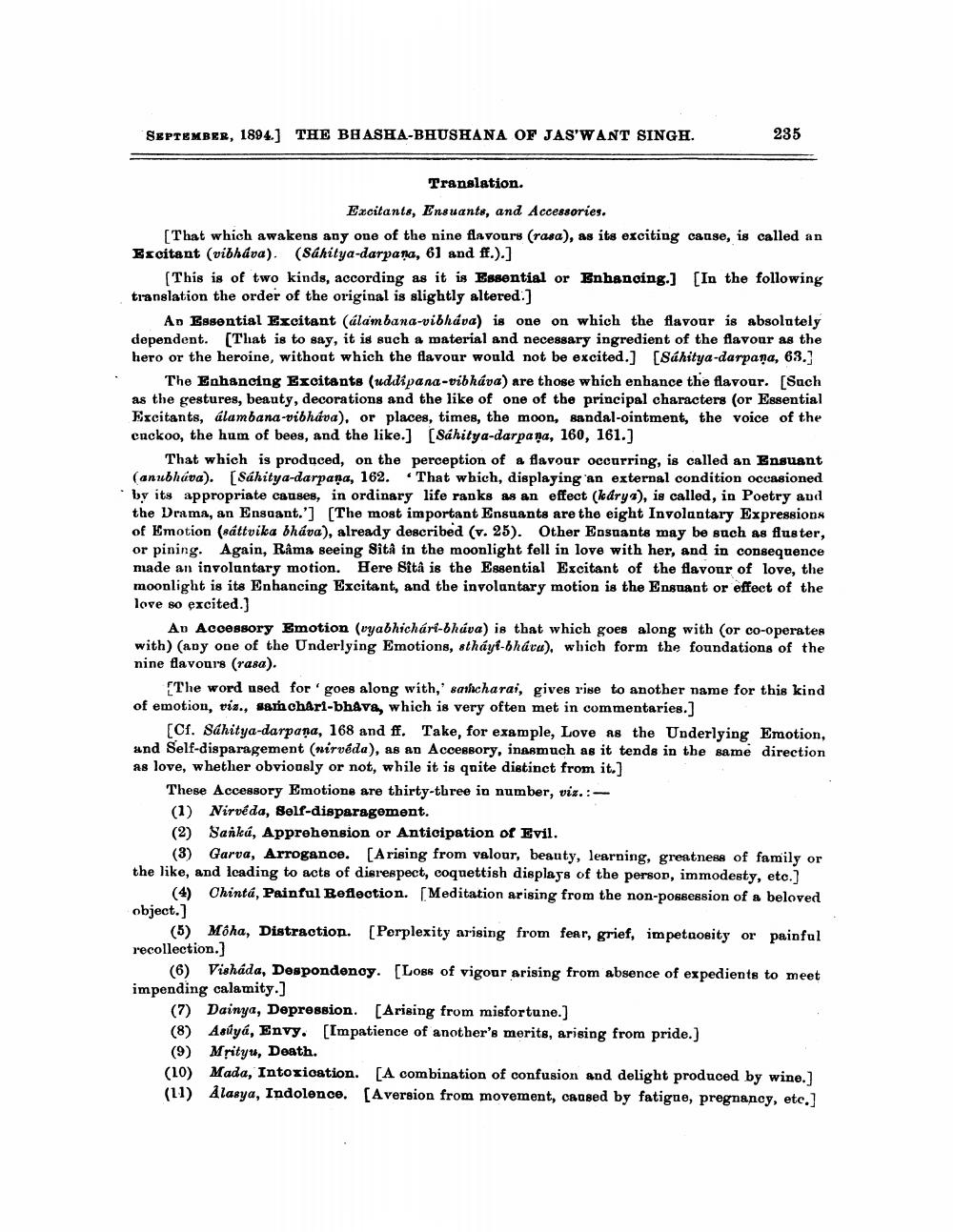________________
SEPTEMBER, 1894.] THE BHASHA-BHUSHANA OF JAS'WANT SINGH.
235
Translation.
Excitants, Ensuants, and Accessories. [That which awakens any one of the nine flavours (rasa), as its exciting cause, is called an Excitant (vibháva). (Sáhitya-darpaņa, 61 and ff.).]
This is of two kinds, according as it is essential or Enhancing.] [In the following translation the order of the original is slightly altered.]
An Essential Excitant (alambana-vibháva) is one on which the flavour is absolutely dependent. (That is to say, it is such a material and necessary ingredient of the flavour as the hero or the heroine, without which the flavour would not be excited.] [Sáhitya-darpana, 63.]
The Enhancing Excitants (uddipana-vibháva) are those which enhance the flavour. (Sach as the gestures, beauty, decorations and the like of one of the principal characters (or Essential Excitants, álambana-vibhava), or places, times, the moon, sandal-ointment, the voice of the cuckoo, the hum of bees, and the like.] [Sahitya-darpana, 160, 161.)
That which is produced, on the perception of a flavour occurring, is called an Ensuant (anubhava). (Sahitya-darpana, 162. That which, displaying an external condition occasioned by its appropriate causes, in ordinary life ranks as an effect (karya), is called, in Poetry and the Drama, an Enguant.'] [The most important Ensuants are the eight Involuntary Expressions of Emotion (sáttvika bháva), already described (v. 25). Other Enstante may be such as fluster, or pining. Again, Rama seeing Sità in the moonlight fell in love with her, and in consequence made an involuntary motion. Here Sita is the Essential Excitant of the flavour of love, the moonlight is its Enhancing Excitant, and the involuntary motion is the Enguant or effect of the love so excited.]
An Accessory Emotion (vyabhichári-bháva) is that which goes along with (or co-operates with) (any one of the Underlying Emotions, stháyf-bharu), which form the foundations of the nine flavours (rasa).
The word used for 'goes along with,' sarhcharai, gives rise to another name for this kind of emotion, vis., samchari-bhAve, which is very often met in commentaries.]
[Cf. Sahitya-darpana, 168 and ff. Take, for example, Love as the Underlying Emotion, and Self-disparagement (nirveda), as an Accessory, inasmuch as it tends in the same direction as love, whether obviously or not, while it is quite distinct from it.]
These Accessory Emotions are thirty-three in number, viz. :(1) Nirvéda, Self-disparagement. (2) Sanká, Apprehension or Anticipation of Evil.
(3) Garva, Arrogance. [Arising from valour, beauty, learning, greatness of family or the like, and Icading to acts of disrespect, coquettish displays of the person, immodesty, etc.)
(4) Chinta, Painful Reflection. (Meditation arising from the non-possession of a beloved object.]
(5) Móha, Distraction. [Perplexity arising from fear, grief, impetuosity or painful recollection.]
(6) Vishada, Despondenoy. [Loss of vigoar arising from absence of expedients to meet impending calamity.]
(7) Dainya, Depression. [Arising from misfortune.] (8) Asuyá, Envy. [Impatience of another's merits, arising from pride.) (9) Mrityu, Death. (10) Mada, Intoxication. [A combination of confusion and delight produced by wine.] (11) Alasya, Indolence. [Aversion from movement, caused by fatigue, pregnancy, etc.]




